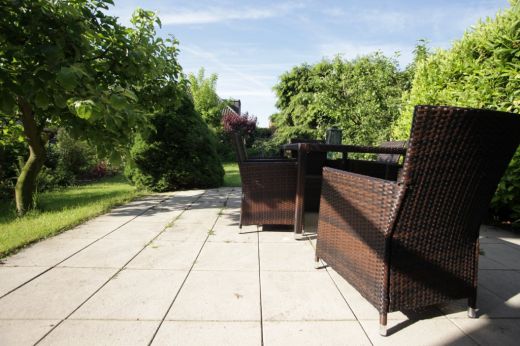Support
You can support this site without any cost or disadvantage at all by clicking this link to Amazon or the one on the left before buying anything – be it underpants, a cupboard, a TV, a pen, a lens or a camera. Amazon is the only shop worldwide, I’m really satisfied with to a 100%, so I have no caveats advertising them. Of course, you can also directly donate a small amount of money, e.g. the amount you would have spent for a magazine, with the button on the left.
Sigma EX 15-30mm 1:3.5-4.5 Aspherical
A solidly built, optically good and quite extreme ultrawide-zoom with old micromotor-AF, which is nonetheless more than fast enough at these focal lengths.
Overall, this is a very fine lens and would be my first and only ultrawide-choice with "fullframe", if it would take filters. In theory, you can take off the foremost part of the lenscap and use the rest to screw-in 82mm filters, but this only works near the maximum zoom-setting without hard, "mechanical" vignetting.
Indeed, I was surprised by this lens. I bought it on ebay for a very low price, hardly more than the shipping-cost, because the aperture-control didn't work (the usual Sigma-broken-flex-cable-problem) and a few scratches on the front-element, one of which is about 2cm long and near the middle, so it was quite a lottery if it'd be visible in photos. To answer this right at the beginning: No, it isn't. I'll show this example in "Lens defects" in a few days. So I didn't expect anything special but was simply curious about it's performance. No I know, why it normally sells for quite high amounts.
COMPATIBILITY
As a classic EF - lens, it mounts on every EOS - body ever made, be it 35mm film, APS, digital APS-C or "fullframe". On APS-C, the smaller sensor of these cameras let's this lens have an angle of view like a 24-48mm-lens would have on 35mm, which, for me, seems useless.
Warning: There's always potential compatibility-issues with third-party lenses and newer bodies and this has happened to Sigma - products more than once in the past, so that I personally rate this risk as high. But keep the price in mind when judging this risk.
PRICE
Prices are moderate in absolute terms and quite high for such an old lens and especially for a Sigma. Good samples sell for well above € 250,- today. Many samples look quite worn and scratches on the body, because Sigmas "EX" finish, despite from being their interpretation of "professional", isn't very durable.
ACCESSORIES
This lens has a built-in shade, that can't be taken off. It was shipped with a pouch of very nice quality, but I don't use it, because thankfully the lens is still compact enough to fit in my normal bags. It is very important that you get the original lenscap with it, as I doubt, that you can buy this anywhere else: One part slips over the shade and has an 82mm-thread in front, where a "normal" 82mm-cap is placed.
You can use 82mm filters instead of the cap when the first part is in place, but there's hard, strong vignetting over most of the zoom-range then, so you can only use it at around 30mm.
MECHANICS
Made in Japan.
Metal lens mount.
Mostly made of metal.
This is a Sigma - pro-grade - lens from the era they startet calling their expensive lenses "EX". It meets high standards regarding materials, built-quality and tolerances. Only the finish is a problem. While not as nasty as the old rubber-style-coating that turns into glue over the years, but still not very durable and getting ugly and looking really worn when it scratches and comes off. Not by far comparable to the first Canon L - lenses like the 16-35mm 1:2.8L.
As I have taken mine apart, I can say, that the interior is made of metal, too, despite from single washers and one of the inner element, which sits in a plastic-thread, screwed into anotherone. I assume, that this lens will nearly last forever mechanically, apart from the flex-cable for the aperture.
The lens is anything, but not small and light.
AF - speed is moderate, but more than sufficent for an ultrawide. The micro-motor is quite loud.
AF accuracy is very good with my lens, nearly dead-on with all of my bodies. This is quite unusual for Sigma-lenses.
During automatic focussing, you can detach the focus ring by pressing it forward, so it doesn't move then. The downside of this solution is, that you still have to move a switch to activate manual-focussing, which is silly: It would be a nice alternative to full-time manual focus, if attaching the focus-ring would be enough to switch between the modes.
The manual focus-ring, when attached and switched to MF feels nice and a bit damped. The inner lens-part extends when zooming within the fixed shade, but has no play at all. Zoom-action is very stiff on my sample.
All in all a very solidly built body with the typical Sigma-flex-cable-problem.
It is worth to mention, that you have to take apart the complete lens down to it's last element to change the cable - this is far from trivial.
ERGONOMICS
Very good, but big and heavy. I hold it right intuitively, gripping it exactly right to zoom or focus.
This lens feels massive, solid and high-quality, but size DOES matter, also see Lenses: What's important?. You can't hold a body with this lens in one hand. It fits in my usual bags, but it's quite near the limit.
The focus and manual focus rings are positioned really well. It has no instant manual override. To switch between AF and MF you have to turn a switch and attach / detach the focus-ring.
On a medium-sized body like an EOS 5D Mark II, it feels solid and big but fits.
There is a focus-scale without infrared-focus-indices but with a depth-of-field-scale.
Overall: Good
OPTICS
Optics of this Sigma are very good.
The minimum focus distance is 0.3m, which is great for an ultrawide.
I expected distortion to be massive because of the quite extreme 15mm, but surprisingly it isn't. In fact it is really low for an ultrawide - I have more than one standard-zoom with a lot more distortion than this Sigma has at 15mm! OK, it might still be relatively strong compared to a 50mm prime, but not for an ultrawide - I know no Canon ultrawide-zoom that is this good. The most annoying thing about it is, that the (low) distortion isn't really uniform, but a bit wavy and so is hard to correct, if you really have to. But this shouldn't be problem when not shooting brick-walls. It gets better in the middle and is nearly free of distortion at 30mm.

15mm: Distortion is hardly visible, despite the straight line running parallel to the border.
The plane of focus is bit curved outwards, you have to focus a little bit closer to get the borders in best focus, but this, too, is quite well controlled for an ultrawide.
Vignetting is bad at 15mm and getting better at the other settings, as expected. This should be a purely physical problem with a fullframe-sensor to a certain degree and not only one of this lens. At 15mm wide open it is surely above 2 stops darker, with a big fading area.This is hardly visible on APS-C.
The aperture is made of 8 blades, giving you very smooth out-of-focus highlights with not-so-great 8-ray-light-stars.
I have no information on this lens' usability for for infrared-photography, sorry.
While I think, that a lens less prone to flare and especially ghosting is not always better, as at least ghosts can be a very nice tool to show the lighting conditions in your pictures, this 15-30mm is quite vulnerable to flare because of it's big, outward bulbed front element, but with it's built-in shade and relatively effective coating, isn't bad in real use. Gladly, lamps, the moon, candles or similar light-sources in the dark aren't a problem and you can always avoid it by changing the angle a bit.
It's color reproduction seems to match my other Canon EF and third-party lenses. It does not have the little bit warmer overall cast, old Sigmas sometimes show.
Lateral CAs (purple/green fringes along high-contrast edges), when not corrected by newer EOS cameras (or nearly all Nikons), are visible and can reach a width of nearly two pixels, I'd estimate. Not unsual for an ultrawide, but this has to be corrected in post-processing, otherwise it's very annoying.
Sharpness is one of the most overrated qualities of lenses. That being said, this lens is very sharp all over the frame and zoom-range at every aperture, apart from the 15mm-corners. These are a complete mush wide open and while getting better when stopping down, they never get really sharp. My Tamron 10-24mm (APS-C!) on fullframe is sharper at 15mm in the corners. But this unsharp area still is quite small and limited, not fading from sharp to soft over a big area, but staying sharp right to the borders with only the last few millimeters of the frame rapdily getting mushy, which shouldn't be disturbing in any real photo. The soft area gets smaller and more well-defined when stopping down and at f/8, it is only the last 100 pixels or so of a 5.600 pixel-wide image, that stay soft. So it isn't a problem and I wouldn't hesitate to call the results "professional" and I think that any pro could easily sell 15mm-shots with this lens without any caveats. Here are some 100% crops from 21MP images from my 5D Mark II:
100% crop, 5D Mark II, 21MP JPG, extreme top right corner, 15mm f/3.5:

100% crop, 5D Mark II, 21MP JPG, extreme top right corner, 15mm f/8:

My sample of this lens is centered well. Sigma seemed to have less problems with centering at that time, than they have today.
This lens very good and I'd use it as my primary or only ultrawide for "fullframe" if it'd take filters. Of course you don't use polarizers with ultrawides, but I do very often use grads to darken the sky and not being able to do so, especially with an ultrawide, where landscapes are by far the primary shooting-object for me, sadly is a show-stopper for me.
I keep it nonetheless, because it isn't worth anything with the huge scratch on the front...
Alternatives
There aren't many alternatives, because noone makes zooms this wide. The Sigma 12-24mm, while being even wider, is probably pretty much the same optically and doesn't take filters, too. Sigmas 17-35mm is worse optically and mechanically and cheaper, takes filters, but quite uncommon 82mm ones and there are known quality issues with the AF-motors. I would skip this one. The Canon 16-35mm in it's first version is definitly softer and the Version II is in a completely different price-class. The 17-40mm is about the same optically but with a more versatile zoom-range on the long end, nearly reaching a non-wideangle FOV, is even better built and takes filters, even quite common 77mm ones, but costs about two times as much. Still, I'd always prefer the Canon over this Sigma, when it's € 250,- to € 450,-. The only exception may be an oportunity like mine - for a few € it's surely a lens worth owning. I have never had the opportunity to test the Tamron 17-35mm, but it also sells for well above € 200,- so I'd always buy the Canon.
A word about supporting this site
I don’t run this site to earn money. I have a real job to earn my living with, a completely normal job. Since everything I write about here I have bought myself, for myself and with my own money from normal shops or ebay-sellers to actually use it, how much and what I am able to write about , depends on the amount of money that I can save and invest in equipment with good conscience. I share all this, because I want to, not to sell it. But when you find this helpful, maybe even as helpful as buying a magazine or book, of course you can support me, if you want. Your benefit is, that you help me being able to afford things to write about here.
You can use the “Donate” – button on the left to directly send a small amount of money (or a big amount, if you insist). You don’t need a paypal account to do so, every method is possible. If you decide to donate 99 cents, I’m thankful for it, because 10 people being as kind as you, make one new filter tested! The default currency is US $, but it works well with € or nearly any other currency, too.
But even more simple and without any cost or other disadvantage at all it is, to simply use this link to Amazon (or the one on the left) before buying anything there. For you it’s exactly the same as going there directly by typing the web-adress in your browser, you just klick this link first! It doesn’t matter, what you buy or where in the world you buy it, be it underpants, a pen, a cupboard, a lens or a Leica M9, be it in Germany, the USA, the UK or Australia: Amazon’s servers simply realize, that you came there through the link on my page and I get a small percentage of anything you buy FROM THEM. There’s absolutely no cost or other disadvantage for you, Amazon simply pays for my “advertisement” through this. I originally didn’t want to ever do any advertising personally. But then I decided to break this rule for Amazon. I’m a completely satisfied customer and buy everything from them. It’s the only shop in the world I would personally and on my private basis really rate a complete 100% in every regard. They have perfect service, even do call you back, answer emails with real, personal writing, extremely fast delivery even on Christmas-day, always perfect and completely new items, are never considerably more expensive than the very cheapest internet-sellers, have an extremely fast refund-system without being picky or having ever displeased me in any way and sell every good I have ever wanted to buy. They work on a completely different level than any retailer I have ever tried, and deliver it directly to me, without robbing me time and money to drive to the city or mall. I wouldn’t advertise them, if I wasn’t convinced, that it is OK to do so.
